
About the Collection
Learn more about the Royal Collection, one of the most important art collections in the world.
History, antiquities, religion and the law
History
The Royal Library’s collection of works on history is particularly strong on British History, but there is also a wealth of material relating to other countries.
Among this collection is a volume of autograph letters to John Jay from the other Founding Fathers of the United States, presented to the future King Edward VII while he was travelling in Virginia in 1860.
Ancient history & antiquities
The ancient history & antiquities section of the Royal Library was primarily acquired by Queen Victoria and Prince Albert. It contains some of the most important works of nineteenth century archaeology including Sir Austen Henry Layard’s two-volume study, published in 1849 and 1853, of the remains of Nineveh and Nimrud in northern Iraq, and Viscount Kingsborough’s monumental nine-volume work, the Antiquities of Mexico (1831–48).
There are also earlier works retained by George IV in 1823, such as the presentation copy of Robert Adam’s 1764 survey of the palace of Diocletian at Split. The Royal Library also holds eight pieces of papyrus dating from the third century BC containing the first eight hours of the Amduat, an Egyptian funerary text that describes the journey of regeneration of the sun god Re through the 12 hours of the night from sunset to sunrise.
British & Irish History
The Royal Library’s collection of works on British History comprehensively covers the history of Great Britain, Ireland, the Channel Islands and the Isle of Man. Much of this material came from the libraries of George III and George IV, with later additions made by Queen Victoria.
Among this collection is an extra-illustrated copy of the Earl of Clarendon’s History of the Rebellion and Civil Wars in England (3 vols, 1707) which was purchased by George III and a manuscript copy of the Book of Ballymote, started at the suggestion of George IV following his visit to Ireland in 1821, and presented to the Royal Library early in the reign of Queen Victoria (c.1837–40).
Commonwealth history
Due to the sovereign’s role as the Head of the Commonwealth, the Royal Library contains material on the history of the Commonwealth and Commonwealth nations.
Some of the most significant items held in this collection include the first history of Malta (1647), a manuscript account of the island of Tobago presented to George IV in 1813, and a lavish two volume survey of Canada, presented to William IV in 1831. The five large maps which accompanied this work were so detailed that copies of them were used for the Canadian census of the same year.
Military history
Expanded in the early-twentieth century on the initiative of the Librarian, military historian Sir John Fortescue, the Royal Library contains an extensive collection of material on military history. Historic texts in this section were principally collected by George IV and include Marmaduke Stalkartt’s Naval Architecture (1781), a beautifully bound volume purchased by the future King at the age of 19, and Drawings of the Colours and Standards of the British Army tempore James II (c.1685–9) a manuscript acquired in 1820.
Seals & Deeds
A collection of wax seal impressions, some of which have deeds and legal documents attached, is housed in the Royal Library. The earliest of these date from the reign of Edward I (r. 1272–1307) and primarily relate to purchases made on the land which now forms part of the Sandringham Estate in Norfolk.
Religion & Theology
In part owing to their role as Head of the Church of England, reigning monarchs have acquired many important works of Religious Literature, and the collection in the Royal Library reflects this. Among the most significant items held in the Library is a copy of Assertio Septem Sacramentorum, Henry VIII’s treatise against the teachings of Martin Luther, which earned him the title Fidei Defensor (Defender of the Faith) from Pope Leo X. The Library’s copy is signed by the King himself (1521).
The Library also holds a Catholic missal used by James II, complete with an added manuscript prayer for the Royal Family. It was the last such book to be used by an English sovereign (1688).
Royal History & Coronations
Orders of service for the Coronations of several sovereigns, as well as commemorative volumes published in honour of the occasion, have been collected. Important examples include John Whittaker’s Ceremonial of the Coronation of King George IV (1823), an extravagant volume printed in gold, and the order of service used and signed by The Queen at her Coronation in 1953.
Heraldry & genealogy
The Royal Library holds a substantial collection of books relating to heraldry and the genealogies of noble houses of Britain and Europe.
Notable among these are heraldic manuscripts, one of which, The Wriothesley Garter Book created around 1535, contains one of the earliest contemporary depictions of Henry VIII seated in Parliament.
Sacred Texts
Amongst the significant collection of sacred texts from around the world are a fifteenth-century copy of the Qur’an, acquired by Queen Victoria in 1898, a Torah scroll, one of 1,564 scrolls saved from desecrated synagogues in Bohemia, Moravia and Silesia during World War II (1830), which is on permanent loan from the Czech Scrolls Memorial Committee, and a copy of the Gita Govinda, presented to King Edward VII in 1875 (c.1790).
Law
In addition to the set of Hansard at the Palace of Westminster, the Royal Library holds a number of standard reference works and historic texts on the development of English, Scottish, and other laws. Among the legal manuscripts in the Library is one of the two Scottish copies of the 1706 Articles of Union – the other is held at the National Archives of Scotland in Edinburgh – and the Jackson collection of fragments, a miscellaneous group containing extracts of canon and common law taken from larger documents.







